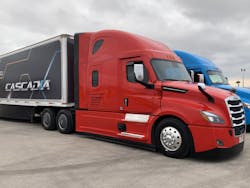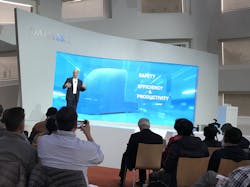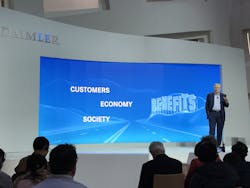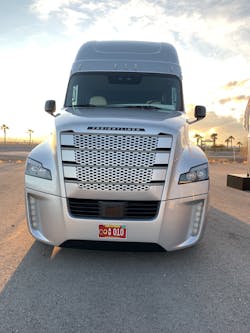LAS VEGAS. Daimler Trucks North America (DTNA) debuted here the first semi-automated truck for the U.S. market.
The model year 2020 Freightliner Cascadia, offering Level 2 automated features and a series of efficiency and safety upgrades, was shown for the first time during a Jan. 7 press conference timed with start of the CES show. Daimler Trucks also announced ambitious plans to bring Level 4 -- or highly automated -- trucks to the United States within a decade.
The company plans to “make automated trucks a true American success story,” said Roger Nielsen, DTNA president and CEO. He added that the new Cascadia is already in “pre-series” production, with serious production scheduled to begin in July.
This year marks Daimler Truck’s first appearance at CES, and gave the company a chance to host its most significant media event in Las Vegas since unveiling a self-driving truck at the Hoover Dam four years ago.
“As a leader of our industry, we’ve been pioneering automated trucking. In 2015, our Freightliner Inspiration Truck got the first road license ever for an automated commercial vehicle,” said Martin Daum, head of Daimler’s global truck and bus unit. “Now we take automated trucking to the next level: we’re ready to launch the first partially automated new Freightliner Cascadia in 2019 – and next, we tackle highly automated trucks.”
Wilfried Achenbach, DTNA’s senior vice president of engineering and technology, summed up Level 2 this way: “The driver remains in control at all times, but is supported constantly by an advanced system that assists with braking, accelerating, and lane keeping.”
Kary Schaefer, DTNA’s general manager of marketing and strategy, said the ability of the Cascadia to independently brake, accelerate, and steer is achieved through the Detroit Assurance 5.0 suite of camera- and radar-based safety systems.
It offers adaptive cruise control down to 0 mph, which the company said can help ease driver fatigue in traffic. The upgraded Active Brake Assist 5.0 also offers full emergency braking when spotting moving pedestrians, and active lane assist, making automated driving possible in all speed ranges.
The latest Cascadia offers a 35% improvement in fuel efficiency compared with the first Cascadia introduced in 2007. Part of the gain is from “Aerodynamic Height Control,” a new feature that electronically lowers the suspension height at 55 mph to optimize airflow over and under the front of the truck and reduce drag.
Meanwhile, as Daimler aims to make its automated vision a reality, it announced plans to invest about $570 million and to create 200 new jobs in the area of highly automated driving. Most of the new positions will be based at the Automated Truck Research & Development Center at DTNA’s headquarters in Portland, OR.
As Daimler moves forward with automated driving, Daum said the company is moving away from platooning.
After years of testing, results have shown fuel savings are less than expected, even in ideal conditions. The benefits are further diminished, Daum said, when the platoon gets disconnected, and the trucks must accelerate to reconnect.
“At least for U.S. long-distance applications, analysis currently shows no business case for customers driving platoons with new, highly aerodynamic trucks, Daimler said in a statement. The company added it remains “committed to all partner projects that are still ongoing.”
About the Author
Neil Abt
Neil Abt is a former FleetOwner editor who wrote for the publication from 2017 to 2020. He was editorial director from 2018 to 2020.



